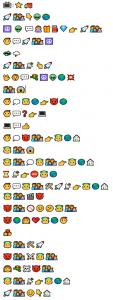
I started “writing” my emoji summary with the title. Right away, I found trouble finding exact emoji’s to represent the actual words. I opted for a mix of direct substitution and similar sounding words to convey the title. Having no context, it would be difficult for a reader to determine which emojis are used as syllables, direct words, or conceptual similarities.
Similarly, the summary was difficult to construct. Trying to figure out how each image could be understood with no context was challenging. One of the more difficult aspects was not being able to use any proper nouns to differentiate each character’s role in the plot. Given how character-driven the story was, this felt problematic. I had to simplify the plot further than I would with a linguistic summary. Initially I tried to focus on the key ideas within the plot, but soon felt more comfortable relying on phrasal representations. I noticed that my use of emojis focused more on the ideas depicted, rather than direct word replacement or syllable construction. I also noticed that I tried to create an emoji mimicry of English syntax. Initially, it was difficult determining how to indicate grammatical structures with emojis, but the more I worked with the emojis, the clearer my chosen patterns became to me. While my choices may not necessarily be clear to anyone else, the more I used my invented emoji language, the easier it was to think in those terms. As I looked for more emojis to express new ideas, I found myself thinking how the idea would fit within the patterns I had already established. I did notice that my attempt at mirroring English syntax made for a heavily linear and directional representation. I played with position of visual phrases, but they did not feel intuitive or coherent enough in relation to the other patterns I had chosen. Trying to create idea breaks beyond simple sentences was difficult, and having no punctuation was extra difficult. Even the use of parenthesis would make creating properties and relationships between ideas significantly easier.
Since my usage of these emojis does not necessarily follow any standardized set of meanings, how someone approaches these visuals can seriously diverge their understanding from my intent. What might I assume might express a clear idea, may have an existing socio-contextual meaning that I am oblivious to, and further obscure it to someone else. Similarly, someone looking at the emojis from a literal standpoint would also have a difficult time discerning which are modifiers and which are integral concepts. This makes creating a true translation from English to an emoji language very difficult. While I can represent my thoughts in a visual medium, I feel as though I am ignoring potentially established iconographic meaning. I am also inventing a syntax and grammatical structure meant to mimic language, but I am doing so separate to any reader. Knowing that there will be an inherent degree of misunderstanding on these multiple levels is somewhat frustrating.